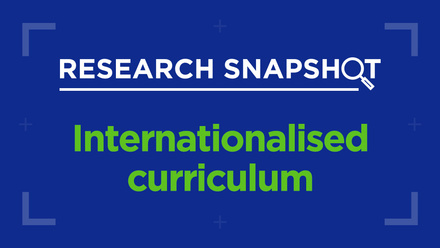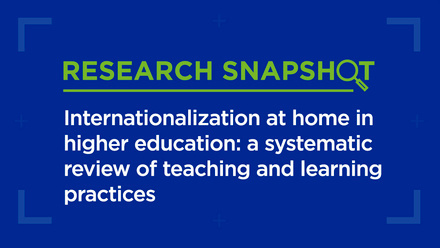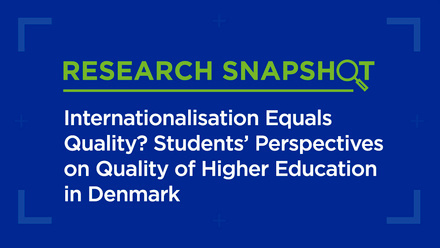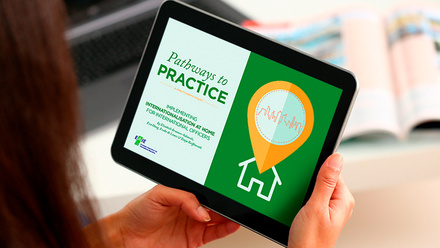Internationalisation at Home in practice

While the European University Association reports that 64% of European universities claim to be involved in Internationalisation at Home, many still question what exactly is meant by the term and how it can be implemented.
Since 1999, the EAIE has supported Internationalisation at Home (IaH) through a Special Interest Group and subsequently an Expert Community. It dedicated an issue of 2015 Winter Forum: Internationalisation at home to the topic, and the annual conference has seen both an increase in the number of proposals for sessions and the number of participants attending those sessions. The IaH LinkedIn group has also grown rapidly over the past two years as we have sought to engage more members in our work.
Internationalisation at Home has been defined as "…the purposeful integration of international and intercultural dimensions into the formal and informal curriculum for all students within domestic learning environments" (Beelen & Jones, 2015). It also has much in common with ‘internationalisation of the curriculum’, a term used less frequently across Europe but which, like IaH, emphasises the importance of internationalising learning outcomes for all students, not simply those who study abroad.
So what does this mean in practice? Here we outline some key features of the Internationalisation at Home approach:
1. Offers all students global perspectives within their programme of study, whether or not they spend time abroad.
IaH is not to be considered a substitute or a ‘second-best option’ for students who may not be internationally mobile during their studies. By targeting all students within their respective programmes of study, IaH integrates global perspectives, thereby enriching the quality of a study programme. Moreover, IaH can be an effective means of Building purposeful partnerships for inclusion – both internationally mobile incoming students and local students from a variety of backgrounds – into teaching and learning processes.
2. Moves beyond electives or specialised programmes.
IaH does not merely target students who may already be interested, but the entire student cohort. Elements of internationalisation are integrated systematically into the compulsory curriculum.
3. Involves developing international and intercultural perspectives through internationalised learning outcomes in the formal curriculum.
International and/or intercultural dimensions are integrated into learning outcomes within the discipline, eg "Students demonstrate understanding of the basic principles of production ecology and agrosystems modelling and their implications for diverse cultural and location-specific contexts"; or "In diverse teams, students are capable of debating the local as well as global impact of relevant risk management strategies."
4. Is supported by informal (co-)curriculum activities across the institution.
As learning not only takes place within formal classroom settings, more informal activities, such as intercultural communication workshops, buddy programmes, language tandems, service learning activities or cultural programmes lend substantial strength to IaH and can help deliver comprehensive internationalisation.
5. Makes purposeful use of cultural diversity in the classroom for inclusive learning, teaching and assessment practice.
In this respect, IaH is strongly learner-oriented. Using cultural diversity as a classroom resource includes finding ways of integrating experiences and knowledge of both internationally mobile students and local students from diverse backgrounds.
6. Creates opportunities for student engagement with ‘cultural others’ in local society.
IaH motivates students to seek ‘the intercultural’ as well as ‘the international’, and to acknowledge effects of globalisation, migration, and cultural diversity on their doorstep. Formal learning scenarios, such as community research projects, might go hand in hand with service learning, excursions, or class visits by community members.
7. Involves all staff, not only academics and international officers.
Since teaching and the curriculum are at the heart of IaH, teaching staff and academics play a crucial role and need to take ownership over IaH measures. However, they also need support from colleagues across the university – including International officers finding their role in internationalisation at home, educational developers, quality assurance officers and faculty administrators.
8. May or may not include teaching in English or another lingua franca.
IaH entails a shift in orientation, not merely translation of an existing curriculum. The adoption of new viewpoints and consideration of global contexts is not language-dependent and may be delivered either through local language or English-medium programmes.
9. Can include virtual mobility through online working with partner universities.
Virtual collaborations, shared teaching materials or even low-threshold activities such as virtual guest lectures expand perspectives in classroom discussions and sensitise students to other forms of knowledge production as well as modes of conducting scientific research. Students gain access to knowledge and material not available on their home campus or, in more collaborative formats, enhance their communicative and social skills.
10. Fosters purposeful engagement with international students.
In both formal and informal learning settings, teaching activities and assignments are designed to stimulate exchange and collaboration among students from diverse backgrounds, whether they are ‘domestic’ or international. Successful IaH does not depend on the presence of international students.
Our role in the Internationalisation at Home Expert Community focuses on building a community of practice and encouraging individuals and universities within Europe and around the world to share ideas and support each other in IaH endeavours. A blog post later this week will look at Internationalisation at Home and institutional strategy.
One way we are trying to share experience is through our Postcards from the Field initiative, launched in May 2018. In just 200 words we ask you to explain how Internationalisation at Home is being implemented in your institution. The postcards are displayed on the EAIE website. Please add your voice.






